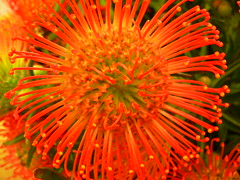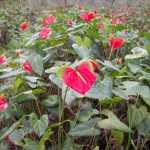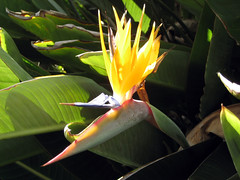Tropical Wedding Bouquets: A Guide to Hawaiian Flowers for Bridal Bouquets
Planning a wedding is tough and selecting the perfect bridal bouquet from a huge catalog of tropical wedding bouquets can be a daunting task. But it doesn’t have to be.
First you must decide which exotic flower you like best. Once you have done this, your choices will be narrowed down dramatically. And from there it is a much simpler task to choose the perfect bouquet for your wedding ceremony.
To help you choose the focal flower of your bouquet, I am going to go over the most popular Hawaiian flowers and once you know the options that you have available this should help to make your decision easier.
I think that you’ll be really pleased by your decision to go with a tropical wedding bouquet because they come in brighter colors, are available year round and they look really chic, hip and modern. After all, who wants to be old-fashioned?
Anthurium
Beautiful anthurium flowers are the epitome of love. They are even shaped like hearts. They come in a huge range of colors and sizes as you can see in this picture of just a few of the varieties of colors from our farm. You should be able to match them to almost any color scheme that you have planned for your wedding as the come in pink, red, orange, green, white, purple, lavender and many other solid and mixed colors.
Plumeria
Plumeria are some of the sweetest smelling flowers that you could use in your bouquet. Some would say that they smell even better than roses and their scent can be very intoxicating. They can be found in a variety of colors, including yellow, pink, gold, orange and red.
Pincushion Protea
If you really want to push the boundaries in your bouquet, you might want to consider these bizarre looking flowers. I might call them bizarre, but they are actually very beautiful they just look different than just about every other tropical flower in the world and they really stand out. They kind of look like pincushions with pins sticking out or perhaps like giant versions of the carnivorous sundew plant, but they are exceptionally beautiful and they don’t bite.
Orchids
Of course the old stand-by, when it comes to tropical bouquets is orchid flowers. You can go with Dendrobiums, Cymbidiums or Phalaenopsis. They all look exquisitely beautiful and have a timeless beauty. They would look just as amazing in your wedding today, as they did back in the 1800s, when they were first brought to Europe by some of history’s greatest explorers.
Bird of Paradise
These enticing flowers received their unusual name because they evoked images of brightly colored birds in flight. With their yellow and orange petals, they almost look like they are on fire and they really create a visual statement against the backdrop of a white wedding dress. They are sure to cause a sensation at your wedding.
So now that you have seen the types of tropical flowers that can be used in your wedding bouquet, all you need to do to narrow the field down is first, consider which flowers come in the colors you have planned for your wedding. And second, just choose a flower that strikes your fancy. That is all there is to it.
Anthurium Nutrients
A Description of the Macro Nutrients Required By Anthuriums
Besides carbon, hydrogen and oxygen, anthurium plants like virtually all other types of vegetation require thirteen elements to grow. Many of the elements are only necessary in trace quantities, but there are six elements that are required in larger quantities and thus are considered to be macro nutrients. They are: nitrogen, phosphorous and potassium (the NPK in NPK fertilizer) and calcium, magnesium and sulfur.
Nitrogen
Nitrogen is an inert gas that makes up roughly 78% of the air we breathe. Can you believe that there is more nitrogen in the atmosphere than oxygen? Anyway nitrogen is very important to plants. It helps them to grow bigger, without it your plants will be stunted. But plants don’t use gaseous nitrogen they generally require it to be fixated or combined with other elements in order to be able to use it. Most of the time bacteria are responsible for fixing nitrogen.
Phosphorus
Phosphorus in its pure form is highly reactive and very dangerous. Fortunately it is not found in this form naturally. It is very important to cell membranes. Without it cells in all plants and animals would die. Plants suck a lot of phosphorus out of the soil and so fertilizers contain large quantities of it. It governs the growth rate of plants and if it isn’t present, plants will cease growing. A slight deficiency will cause stunting of anthuriums, while a severe deficiency will cause necrosis of the foliage.
Potassium
Potassium is quite similar to sodium and in elemental form it will liberate hydrogen gas when dropped in water. The heat generated by this reaction will then ignite the hydrogen. A lack of potassium will cause the leaves of your plant to turn yellow. If the deficiency is severe enough the yellow spots will eventually turn necrotic and the leaf will die.
Calcium
Calcium is important for building strong bones and generating action potentials in nerve cells. Without it, we wouldn’t last very long. Calcium is also very important to plants. With calcium deficiencies we see many of the same problems as with magnesium deficiencies: chlorosis and necrosis. But calcium deficiencies may also cause irregular leaf borders to develop.
Magnesium
Magnesium is a light metal that is used in high end automobile and aircraft parts. It too is highly reactive with oxygen and can catch fire under the right conditions. It seems like we are seeing a pattern here with all of these metallic elements. A deficiency will result in chlorosis and eventually necrosis, so make sure your plant gets enough of this element too.
Sulfur
Sulfur, or brimstone, is the element associated with the devil in ancient times. But this “evil” element is quite important to us and to our plants. It is the seventh most abundant element in the body and it a very important part of all proteins. Sulfur is very important for repairing oxidative damage in the body and it is important to plants too. Without it, your plants will not grow well and will be stunted.
Conclusion
So there you have it. These are the essential macro nutrients that all anthurium plants require. Without them your plant will stop growing and producing flowers and may even die. So make sure that your anthurium gets all of these nutrients. And it probably is a good idea for you to get these nutrients too, but of course we have to get these nutrients from food, not from a bag of fertilizer.
Tropical Flower Names
Not only do tropical flowers look exotic, but many also exude evocative fragrances that can evoke memories of sultry nights spent in faraway island paradises. Here are the names of some of my favorite tropical flowers.
Anthurium
There are many different species in the anthurium family. The most popular flower variety is Anthurium Andreanum which produces heart shaped flowers of many different sizes and colors. Some popular names include: Flamingo Flower, Obake, Midori, Ozaki, and Princess Lily.
Torch Ginger
The torch ginger, or Etlingera elatior, originally comes from Asia. It is pink, red or yellow-orange in color and it kind of looks like flames coming off a torch, hence its name. The seed pods of certain varieties may be used in cooking fish dishes in some parts of Asia. Sometimes the flower buds are also used in cooking. But I’d much rather look at these beautiful flowers than eat them. Sometimes they can grow up to fifteen feet high.
Bird of Paradise Flower
These flowers are originally from South Africa. It received its name because the flower it produces looks like a bird of paradise, which is a species of bird found in New Guinea.
Heliconia
These are a genus of roughly two hundred species that are found in the pacific and in South America. They produce bright red and orange flowers and when they are not in bloom they sort of resemble plantains or banana plants. Some variety names include: Yellow Christmas, Red Holiday and Yellow Dancer.
Tulip Anthurium
These types of anthuriums have a shape that may remind you of tulip flowers. These varieties were produced by crossing Amnicola with Andraeanum. They may come in white, pink, red and purple. Unlike other anthuriums, several varieties have a sweet, pleasing fragrance.
Ginger
There are many different varieties of ginger flowers like torch ginger, red ginger and pink ginger. And I have not even begun to scratch the surface. The roots of some varieties of ginger plants are also used to make the ginger spice that is used in cooking.
Protea
This variety of flowers was named after the greek god Proteus, who could change form at will. It is a very ancient variety of plant that originated over 300 million years ago and is originally from South Africa. It has feather petals that could easily be mistaken for feathers. Some common names include: King, Pink Ice and Carnival.
Plumeria
The plumeria originated in Central and South America. It produces a flower with a very lovely scent. In Hawaii, it is frequently used in lei-making, because it is both beautiful and it smells good.
Orchid
Orchids are probably the most popular tropical flower in the world. They are grown by millions of people. There are thousands of species of orchids and many more are being created each year. They can grow just about everywhere, except on glaciers. There is even an edible variety of orchid: you may know it as vanilla.
Obake Anthurium
“Obake” means “change” or “ghost” in the Japanese language. These flowers usually consist of two or more colors. Most of the time one of the colors is green and the other colors may be orange, red, pink or white. Obake anthuriums usually produce some of the biggest anthurium flowers and they are often elongated in shape and very curly or wavy. They are usually the fanciest and most pricy type of anthurium flowers, but they are well worth every penny.
Red Ginger
Red gingers (which are also known as Alpinia purpurata) are another plant from Asia, Malaysia to be specific. It produces red flower (of course) and it can also be found growing in Hawaii and South America. The red cone is commonly thought to be the flower, but it really is consists of bracts which are reddish colored modified leaves. The real flowers are whitish and form inside of the reddish cone.
Pink Ginger
Pink ginger looks a lot like red ginger, but it is pink. (Now this is a big surprise.) They are very closely related to red ginger and come from the same place, Asia. It belongs to the same family as edible ginger.
Hibiscus
The yellow hibiscus is the state flower of Hawaii. This genus of plants grows through out the world, where ever tropical climate conditions exist. Most of the time it is grown as an ornamental plant, but a few varieties are used to make tea.
Pink Mink Protea
These flowers come from South Africa. Their petals resemble pink feathers and they look quite exquisite. Did you know that Proteas are the national symbol of South Africa? They also grow very well in Hawaii, but the emissions from the Kilauea volcano have been causing heavy damage to the crops of protea farmers in Kau. So this has been hurting the supply of proteas from Hawaii. Proteas also make excellent dried flowers. You can hang them upside down and let them dry out and they will continue looking almost as good as when you first got them.
Pincushion Protea
These interesting flowers are also from South Africa. Based on their name, I’m sure that you can guess what they look like. They look like pincushions with pins sticking out of them. This is probably the perfect flower for someone who likes sewing.












